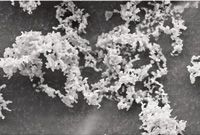Beyond Micronization
Emerging methods could provide alternative ways of producing inhalable drug particles.
Ask any manufacturer what process it uses to make inhalable drug particles, and the answer is likely to be micronization. This process has been the industry standard for decades, but it is not necessarily ideal. For starters, micronization is not well understood. In addition, a certain amount of material is lost during the process, so its final yield may not be optimal. Given these conditions, manufacturers have good reason to look for alternative processes for making inhalable medicines. Fortunately, several emerging methods show promise.

IMAGE: INFLUX PRODUCTIONS, PHOTODISK, GETTY IMAGES
Particle replication in nonwetting templates
In 2005, researchers at the University of North Carolina (UNC) at Chapel Hill developed a technology called Particle Replication in Nonwetting Templates (PRINT). The method is based on the computer industry's procedure for making transistors, says Joseph DeSimone, professor of chemistry at UNC and leader of the research team. Using established technology, the researchers made etched silicon wafers to serve as templates for drug particles with previously determined characteristics. Using a template enables manufacturers to design the size and shape of their drug particles precisely, to target the upper airway or the alveolar sacs effectively, for example.
To scale up production, the team made a drum to pattern a print mold made of film that can be from 6 to 24 in. wide. The drum can make thousands of linear feet of molds, depending on the number of particles required.
After the molds are complete, their cavities are filled with the inhalable formulation, which can include the active ingredient alone or with excipients. Particles are harvested by adhesive films.
The PRINT technique, which complies with cGMP, can create traditional and large-molecule drugs for various diseases, including respiratory ailments such as cystic fibrosis and chronic obstructive pulmonary disease. The method also could be used to manufacture particles to fight bacterial infections or deliver chemotherapeutic agents to the lung. The researchers are interested in targeting the central nervous system through inhaled particles made using the PRINT process, says DeSimone.
A significant advantage of the PRINT method is that it consistently yields uniform populations of particles. "There's essentially no dispersion in size and shape. That's not been available before," says DeSimone.
The technology also lets formulators create particle sizes and shapes that traditional methods have not generated successfully in the past. For example, DeSimone's team has made cylindrical particles that are 80 nm in diameter, and they can achieve particle sizes as large as 5 µm. The team is also using PRINT to develop particles that can rotate automatically in a low-velocity airstream, much like a maple seed does when it falls from a tree. "We're getting into characteristics that have never been designed into a respiratory drug therapy," says DeSimone.
It's hard to achieve this kind of mixture through traditional particle approaches, such as spray drying from a solution, because ingredients in various phases tend to separate, and the processes give operators little latitude for controlling the ratio of matrix to drug. "With PRINT, we can precisely tailor the ratio of those two components because we're simply filling a cup," says DeSimone. The high level of control that PRINT offers could help manufacturers create multicomponent particles for targeted delivery.
On the other hand, risk-averse drug manufacturers could consider the PRINT technique's novelty a liability. Companies might be inclined to use micronization because they are familiar with that process. Also, the throughput of the PRINT technique, which has a two-dimensional format, is lower than that of volumetric processes such as spray drying.

Respirable drug particles processed through supercritical antisolvent precipitation.
Nevertheless, the PRINT technique shows great promise for manufacturing inhalable drug particles, according to DeSimone. The method can enable continuous manufacturing; provide control of size, shape, and chemical composition; enhance drug stability; and enable particles to be made from otherwise challenging formulations.
Supercritical-fluid technology
Supercritical-fluid technology, a more established method than PRINT, may soon be used to manufacture an FDA-approved drug. MAP Pharmaceuticals has been producing Levadex, its orally inhaled migraine therapy, through supercritical-fluid crystallization. The company completed clinical development for the drug last year and will submit a New Drug Application during the first half of 2011, according to the Form 10-K filed on Mar. 4, 2011.
Supercritical-fluid technology has been around for more than a century, and it is a common method for making decaffeinated coffee. In the mid 1990s, the pharmaceutical industry began examining the technique as a way of manufacturing drug particles. Because the process is rapid, and because no solvent is present during crystallization, drugmakers thought that supercritical-fluid technology could yield uniform particles.
Supercritical fluids could be considered a fourth state of matter that combines the properties of liquids and gases. These fluids can act as solvents or antisolvents. Carbon dioxide becomes a supercritical fluid when it is heated above 31.1 °C and held at a pressure higher than 73.8 bar. Because of these characteristics, carbon dioxide has become the most common supercritical fluid in the pharmaceutical industry.
Supercritical antisolvent precipitation (SAS) is one way to produce inhalable drug particles. In this method, a solution of drug and organic solvent (e.g., budesonide in ethanol) is introduced into a flow of supercritical carbon dioxide, which extracts the solvent rapidly from the drug solution. The drug substance then becomes supersaturated and forms particles in milliseconds. Variations in SAS processes are distinguished by the ways in which the drug solution and supercritical fluid interact. Some SAS processes are more efficient than others, but each of them yields dry powders in a single step.
Because carbon dioxide's critical temperature is not much different from ambient conditions, SAS is an attractive method for processing pharmaceuticals, says Peter York, chief scientist at CrystecPharma and emeritus professor of physical pharmaceutics at the University of Bradford, United Kingdom. The process yields dry powders without additives or residual solvents that might be unacceptable to regulators.
In addition, SAS results in particles that have highly desirable properties for inhalation medicines. The particles generally are smaller than 10 µm and have a narrow size distribution. The process is tunable and can make 1–3-µm particles (e.g., for targeting the deep lung) or 3–5-µm particles (e.g., for targeting the upper respiratory airways). Particles made through SAS also are highly crystalline, free from amorphous domains, and, thus, highly stable. The particles' surfaces tend to be smooth and regular with low surface energy, and these characteristics reduce agglomeration and help improve downstream handling.
In the past 15 years, technology has advanced to the point where SAS can produce materials at manufacturing scale that comply with cGMP. New developments at CrystecPharma enable composite particles containing defined ratios of two or more drug substances (e.g., for combined drug therapy) to be manufactured. Clinical evidence indicates that SAS improves the performance of drug materials, compared with other manufacturing techniques. Products containing SAS-processed particles have improved drug bioavailability, led to simplified formulations, and reduced required doses, says York.
SAS also is superior to micronization in several ways. During micronization, particles are bombarded against the walls of a mill, and this intensive process can create high-energy sites on the surfaces of the materials being milled. These high-energy sites can cause potential chemical or physical changes in the material. One of the most problematic changes is the introduction of noncrystalline or amorphous domains in the product, which can reduce its stability. Micronized material also has highly charged surfaces and tends to be cohesive and difficult to disperse into an aerosol, says York.
Yet many drugmakers might be reluctant to abandon micronization because they have years of experience with the process—and have invested considerable sums into the technology and training required. The industry's overall conservatism and antipathy to change also could slow companies' adoption of SAS, in spite of the method's advantages.
If FDA approves Levadex, however, it would be the first product on the market manufactured through SAS. "That will take the risk out of these processes for a lot of potential clients," says York.

INTERPHEX 2025: Use of Walk-In Chambers for Bio/Pharma Development and Manufacturing
April 2nd 2025Sitting down with the PharmTech Group at INTERPHEX 2025, Christopher Murphy, director of Global Business Development and Service Customer Support at Environmental Specialties, discusses the design and critical role of walk-in chambers in the bio/pharmaceutical industry.
Drug Solutions Podcast: A Closer Look at mRNA in Oncology and Vaccines
April 30th 2024In this episode fo the Drug Solutions Podcast, etherna’s vice-president of Technology and Innovation, Stefaan De Koker, discusses the merits and challenges of using mRNA as the foundation for therapeutics in oncology as well as for vaccines.
WMFTS’ BioPure to Showcase Single-Use Bioclamp with Refined Manufacturing at INTERPHEX 2025
April 1st 2025With advanced manufacturing, BioPure’s BioClamp connector is manufactured to be 13% lighter than the previous model, resulting in a 26% reduction in carbon dioxide emissions across the full lifecycle of the product.